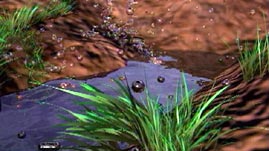Teachers' Domain - Digital Media for the Classroom and Professional Development
User: Preview

Source: NASA/Goddard Space Flight Center Scientific Visualization Studio
The water cycle is Earth's natural mechanism for transporting and recycling water between the surface and the atmosphere. Through the processes of condensation, precipitation, infiltration, runoff, transpiration, and evaporation, water continuously travels from the atmosphere to the ground and back again. In this animation from NASA, observe the steps of the water cycle.
As long as there has been water on Earth, it has participated in a continuous exchange between the surface and atmosphere. Water vapor in the atmosphere condenses to form clouds, which can produce precipitation. Rain, snow, and sleet return water from the atmosphere to Earth's surface. On the ground, the water cycle continues with infiltration (precipitated water seeps into the ground), runoff (water flows off the land into rivers, lakes, and oceans), and evapotranspiration (liquid water changes into vapor and is returned to the atmosphere by transpiration from plants and evaporation from surface water).
The phases of water depend on the motions of its molecules. When water exists in its liquid phase, the average kinetic energy of the water molecules is high enough for them to move freely around each other. This happens when temperatures range from 0°C to 100°C (32°F to 212°F). If the molecules do not have much energy of motion, such as when the temperature is below 0°C (32°F), their movement slows and they jiggle in place, creating the solid phase of water — ice. If the average kinetic energy of water molecules is very high, such as when the temperature is above 100°C (212°F), the molecules move very fast, bounce off each other, and spread out in the gaseous form — water vapor.
A molecule of water contains two hydrogen atoms and one oxygen atom. The way these atoms are joined together results in water molecules acting somewhat like miniature magnets. Water molecules have a positive side and a negative side and, as such, are strongly attracted to each other (hydrogen bonding). This attraction is what makes water molecules stick together to form droplets in clouds and helps water travel up through the roots of plants.
The Sun causes evaporation by heating liquid water on Earth's surface. Another process that releases water vapor into the atmosphere is transpiration — the evaporation of water from pores in the leaves of plants. Water vapor in the air is invisible — clouds and steam are actually millions of tiny droplets of liquid water or ice that form when the gaseous water molecules lose energy and condense around small particles in the air. As more water molecules collect on the cloud droplets, the drops get too heavy and fall from the cloud back to Earth's surface as precipitation.
 Loading Standards
Loading Standards Teachers' Domain is proud to be a Pathways portal to the National Science Digital Library.
Teachers' Domain is proud to be a Pathways portal to the National Science Digital Library.
